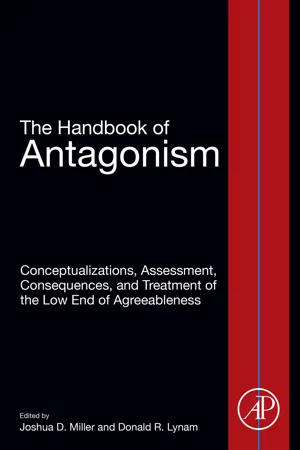
The Handbook of Antagonism
Conceptualizations, Assessment, Consequences, and Treatment of the Low End of Agreeableness
- 438 pages
- English
- ePUB (mobile friendly)
- Available on iOS & Android
The Handbook of Antagonism
Conceptualizations, Assessment, Consequences, and Treatment of the Low End of Agreeableness
About This Book
The Handbook of Antagonism: Conceptualizations, Assessment, Consequences, and Treatment of the Low End of Agreeableness looks at the theoretical and empirical underpinnings of antagonism, highlighting the consequences of the trait, its role in a number of problem behaviors and psychiatric disorders, and how it exerts itself on externalizing behaviors. Covering the biological and evolutionary roots of antagonism, the book provides clinical insight on assessment strategies, while also outlining a number of treatment techniques, including motivational interviewing, cognitive behavioral therapy, interpersonal psychology and psychodynamic treatment approaches.
In addition, the book explores the development of antagonism across childhood and adolescence, discussing the societal consequences of the trait, as well as its role in a number of problem behaviors, such as aggression, violence, crime and substance use.
- Provides an overview on the development, assessment and treatment of antagonism
- Looks at antagonism's role in work, romantic relationships and other domains
- Outlines self-report and non-self-report assessment approaches
- Studies the links between antagonism, psychopathy, narcissism and antisocial personality
- Approaches antagonism from a dimensional trait model
- Analyzes the role antagonism plays in several prominent psychiatric disorders
Frequently asked questions
Information
On the ubiquity and importance of antagonism
† Department of Psychology, University of Georgia, Athens, GA, United States
Abstract
Keywords
What is antagonism?
| Facet | Antagonism | Agreeableness |
|---|---|---|
| Callousness vs compassion | Exploitative Callous Ruthless | Altruistic Empathic Tender-minded |
| Immorality vs morality | Manipulative Deceptive Cunning | Confiding Honest Straightforward |
| Distrust vs trust | Skeptical Suspicious Cynical | Trusting Naïve Gullible |
| Combativeness vs affability | Oppositional Aggressive Quarrelsome | Cooperative Polite Docile |
| Arrogance vs modesty | Boastful Egocentric Self-centered | Humble Unassuming Self-effacing |
Antagonism in basic models of personality
Table of contents
- Cover image
- Title page
- Table of Contents
- Copyright
- Contributors
- Preface
- 1: On the ubiquity and importance of antagonism
- 2: Five-Factor Model antagonism
- 3: Antagonism from a developmental perspective
- 4: The structure of antagonism
- 5: Self-report assessment of antagonism
- 6: Biological correlates of antagonism
- 7: Agreeableness, antagonism, and mental health across cultures
- 8: Translational value of nonhuman primate models of antagonism
- 9: Theoretical conceptualizations of agreeableness and antagonism
- 10: A social cognitive analysis of antagonism and reactive aggression
- 11: Antagonism from the perspective of interpersonal theory
- 12: Antagonism's place in psychiatric nosology
- 13: Antagonism and the DSM-5 alternative model of personality disorders
- 14: Antagonism in psychopathy
- 15: A Trifurcated Model of Narcissism: On the pivotal role of trait Antagonism
- 16: Antagonism and borderline personality disorder
- 17: Antagonism in the Dark Triad
- 18: Antagonism and romantic relationships
- 19: Antagonism and work outcomes: Implicit and explicit considerations
- 20: Antagonism and crime
- 21: Stability and change in antagonism over the lifespan
- 22: Treatment of antagonism: Motivational Interviewing
- 23: Psychodynamic approaches to treating antagonism
- 24: Treatment of antagonism: Cognitive behavioral therapy
- 25: Addressing antagonism in a Dialectical Behavior Therapy framework
- 26: Pharmacologic interventions for antagonism and related disorders
- 27: Volitional change in antagonism
- Index